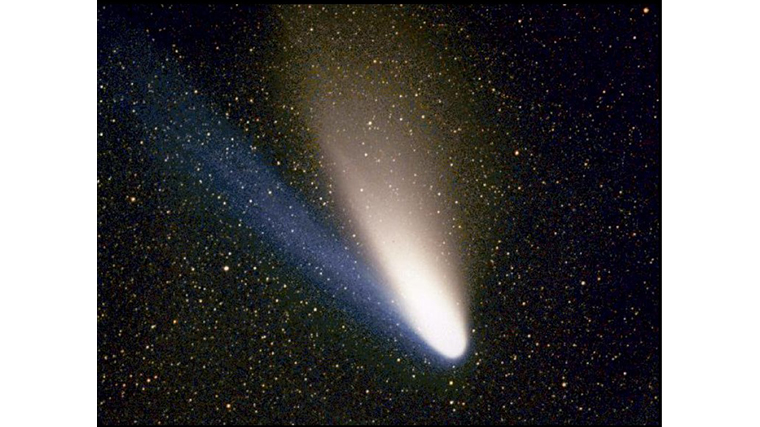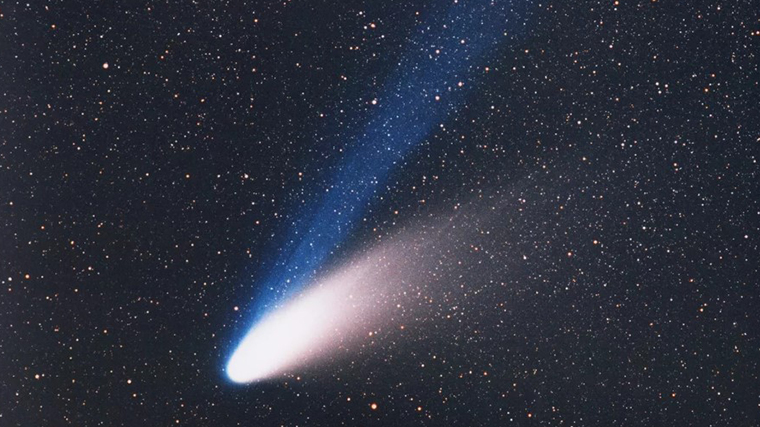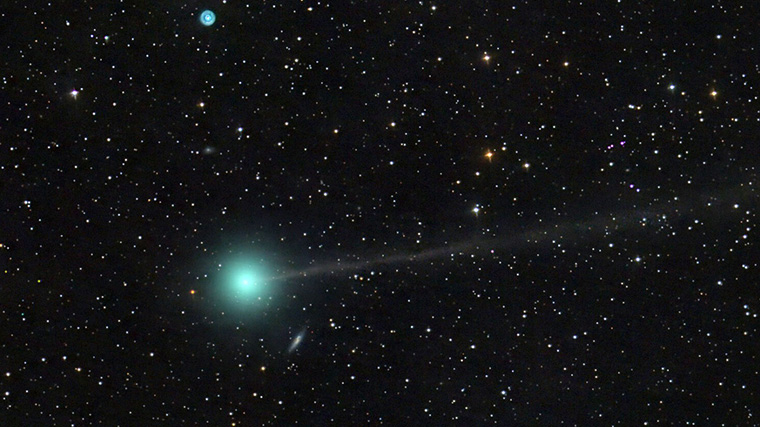As Hale-Bopp approached Earth for a month, its descriptions ignited interest in newspapers and the emerging Internet. “Numerous websites with Hale-Bopp information caused Internet traffic jams,” noted Scientific American in March 1997. NASA’s Jet Propulsion Laboratory’s Hale-Bopp homepage drew 1.2 million daily visitors during Easter weekend, spawning two mirror sites.
Professional observatories also tracked the comet. NASA employed the Hubble Space Telescope, revealing an “enormous” nucleus, measuring 19 to 25 miles (30 to 40 kilometers) in diameter.
The most astonishing finding was the comet’s substantial dust emission—over eight times greater than typical observations of previous comets. “Hale-Bopp’s nucleus surface appears dynamic, with ‘vents’ activating as new icy patches face the Sun,” explained Harold Weaver, an astrophysicist at Johns Hopkins University and leader of the Hubble study.
What do we know about her?
Comet Hale-Bopp is known as one of the most popular comets in history.
Comet Hale-Bopp was an unusually bright comet that passed by Earth, reaching its closest approach to the planet in 1997. It was the most spectacular in the Northern Hemisphere and was visible to the naked eye for about 18 months.
Comet Hale-Bopp was probably one of the most viewed comets in history. According to NASA, with an absolute magnitude of -1, the comet was one of the brightest comets to reach the inner solar system in the history of observations. At the same distance, Hale-Bopp’s comet seemed 1000 times brighter than Halley’s Comet. Its twin blue-white tails were visible even from light-polluted areas like Chicago.

Who opened it?
Comet Hale-Bopp was discovered independently by two amateur astronomers, Alan Hale in New Mexico and Thomas Bopp in Arizona. According to NASA, at the time of its discovery, the Hale-Bopp comet was the most distant comet ever discovered by amateurs.
Both men pointed their telescopes at the nearby globular cluster M70 on July 23, 1995. sky.
“As soon as I looked, I saw a fuzzy object nearby,” he said in a 1997 interview with Time magazine. “It was strange because I had looked at M70 a couple of weeks earlier and that object wasn’t there.”
Hale recalled looking up at the sky a few hours later and seeing that the object had moved. In his opinion, he told Time, it was a comet.
Almost simultaneously, Bopp saw the same object in the sky. Both men sent their observations to the International Astronomical Union’s Central Bureau of Astronomical Telegrams.
The astronomers were amazed at how bright the comet, officially designated C/1995 O1, looked even from a great distance. While they expected the comet to be bright as it approached Earth, predictions are difficult when it comes to comets – they’re just balls of ice and dust that erupt in ways that are hard to anticipate.
According to NASA, Hale-Bopp’s maximum approach to Earth occurred in March. Dec. 22, 1997, at a distance of about 120 million miles (193 million kilometers). (For comparison, the Sun is 93 million miles or 150 million kilometers away from Earth.)
Where did Hale-Bopp come from?
Comet Hale-Bopp is categorized as a long-period comet as having an orbital period exceeding 200 years. These comets typically follow highly elliptical orbits, making their trajectories less predictable than short-period comets.
Hale-Bopp, like other long-period comets, likely originates from the Oort Cloud, a distant cluster of icy bodies positioned approximately 2,000 to 100,000 astronomical units (a.u.) from the Sun. (One a.u. equals Earth’s distance from the Sun, about 93 million miles or 150 million kilometers.)
Objects within the Oort Cloud are at such vast distances from the Sun that gravitational influences from nearby stars, molecular clouds, or even the Milky Way’s tidal forces can dislodge them from their icy reservoirs, propelling them into highly elliptical orbits around the Sun.
Comet Hale-Bopp and the Marshall Applewhite cult.
Heaven’s Gate, led by Marshall Applewhite, a former music professor, was a cult advocating abstinence and even castration. They believed their bodies were vessels, to be abandoned for a higher existence while tracking an alien spaceship near Hale-Bopp.
In late March 1997, Applewhite and 38 followers consumed a fatal mix of phenobarbital and vodka, anticipating a transition to the alien vessel and a superior state in Heaven’s Gate. The 21 women and 18 men were discovered in a San Diego mansion, wearing matching attire and new sneakers.
The suicides were likely connected to the Hale-Bopp comet’s appearance, perceived by the group as a cosmic signal to journey to another realm, as The New York Times reported in March 1997.
When’s Hale-Bopp coming back?
Hale-Bopp marked a pivotal moment in astronomy, urging scientists to maximize observations during its brief passage near Earth. Its prior visit occurred some 4,200 years ago, and it won’t revisit our inner solar system for millennia.
European Southern Observatory (ESO) astronomers released images of Hale-Bopp in 2001, post its 1997 proximity, when it had expanded 1.2 billion miles from Earth, aligning with Saturn and Uranus orbits.
Notably, ESO reported anomalous activity for a “dirty snowball” like Hale-Bopp, suggesting ongoing activity despite its extremely low temperature. This assessment was derived from La Silla telescope observations in Chile.
Comet study proves intricate due to the challenge of predicting their brightness. The Rosetta spacecraft circled comet 67P/Churyumov-Gerasimenko between 2014 and 2016, yielding insights into cometary behavior under solar influence, and refining brightness predictions.
While amateurs occasionally spot comets, automated spacecraft dominate discovery. The Solar and Heliospheric Observatory (SOHO) satellite, designed for solar research, adeptly captures comets near the Sun. SOHO has cataloged over 3,000 comets since its 1995 launch.
Notably, only the James Webb Telescope can spectroscopically examine Hale-Bopp in near-infrared, and no other comet will be observed at a distance of 46 a.u. during JWST’s lifespan. This distance corresponds to the Kuiper Belt, where cometary surface ices remain thermally stable.
Hale-Bopp’s comet made a strong impression on people, surpassing even Halley’s comet in 1986, and became perhaps the most “observed” comet, as it was seen by more people than any previous appearance of Halley’s comet. The comet broke many records: it was detected at the farthest distance from the Sun (among the comets known at the time), had (arguably) the largest nucleus, and was observed twice as long as the previous record holder. It also remained brighter than zero magnitude for 8 weeks.
Image credit:
https://ru.wikipedia.org
https://www.space.com

